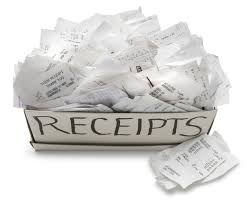Paper, paper, paper.. We have been dealing a lot of paperwork in our lifetime and we are constantly organizing, throwing and even keeping them, which make the clutter grow over time.
Today, I will help you on how you can properly organize your receipts and bills so you can stop the clutter before it happens. So let’s start off with…
Tip #1: Throw out old receipts and ATM Slips
Do you really need to keep those ATM slips? Most definitley not. Once you’ve made a transaction and checked the records and balance you won’t need that ATM slip anymore. The same holds true for receipts on purchases that have been used or when the warranty is void.
Only keep receipts that has replacement orders, or those that are necessary for tax purposes.
Tip #2: Final Bank Statements must be kept up to Seven Years
Why? You’ll need to keep any paperwork that supports your tax return until that audit window closes. Among the additional documents you should retain: canceled checks and receipts for all deductible business expenses (such as those for entertainment, home-office equipment, and professional dues), retirement-account contributions, charitable donations, child-care bills, out-of-pocket medical expenses, alimony, mortgage-interest and property-tax payments.
Another thing you need to keep are receipts from your home improvement project. It allows you to keep track of the expenses made on your house to satisfy potential buyers and to reduce possible capital-gains taxes when you sell your home.
Tip #3: Have a designated storage area for your paperwork
Have an area where you can properly organize your paperwork. Preferably near a table so you can write and sort them. Place them in envelopes or folders for easy filing.
Keep your will, birth and marriage certificates, insurance policies, property deed, and other permanent records in a safe but accessible place near your other financial documents, so you and your heirs will always be able to get to them quickly, if needed.
Tip #4: Have a Systematic Way in Processing your Paperwork
Develop a system from the time you receive the bills to payment until proper filing. It is really important that you know what to do next after you receive your statement. Remember your goal is to be able to clear out your payables within the month and then filing them for taxes.
Now here’s the key: Once you’ve paid the bill or checked the statement, file it immediately. “Your goal should be to touch a piece of paper a few times, rather than shuffling it from pile to pile,” says Paula Boyer Kennedy, a financial planner in the Minneapolis office of Ernst & Young. “If you stick the bill back in the drawer after you pay it, it will find friends, and they will mate and produce offspring. Pretty soon, you’ll have a true litter.”
Tip #5: Work on the Backlog
Once you have a system in place, it’s time to organize paperwork that have been sitting there for ages. You can tackle them by sections, so you won’t get overwhelmed.
You’ll be amazed at the difference a little organization makes. “People don’t realize how much they pay as a result of having their financial records in disarray―a late credit-card charge here, a lost tax deduction there,” says Stephanie Denton, a professional organizer in Cincinnati. Even greater, though, may be the long-term mental and financial benefits. Once you’re organized, “you can focus your mental energy on the really important stuff, like your investments and your financial goals,” says Terry Savage, author of The Savage Truth on Money (amazon.com). “Getting your financial papers in order pays big dividends in peace of mind.”
Reference: RealSimple.com
———————
Elaine Fernando is a Professional Organizer, a member of the National Association of Professional Organizers (NAPO) and a member of APPO (Association of Personal Photo Organizers). Elaine may be reached at 908-630-8995 or [email protected]












